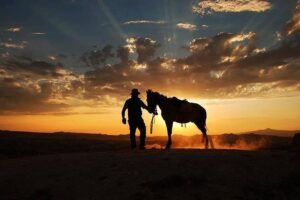
Pigeon Valley (Güvercinlik Vadisi in Turkish) which connects Üçhisar to Göreme. Most of these cave dwellings have been painted white to attract the birds and their valuable droppings.
The fairy chimneys to the west, east and north of Uçhisar were hollowed out and used as graves during the Roman period. Inside these rock cut tombs, the entrances which generally face west, are klines or stone slabs on which the bodies were laid.
Babayan is its old name, now it is called as İbrahimpaşa. It hasn’t strange rock formations but it has beatiful stone houses.
Ortahisar is famous for its friendly inhabitants, picturesque stone houses, narrow streets and lovely churches as well as the castle-like rock formation after which the town is named. This 90m high natural fortress, a promient landmark in the region – honeycombed with caves and tunnels, camouflaged by nature without the slightest indication of human presence inside – has partly crumbled away revealing some of its interior. Today it has been restored and the peak is accessible by a staircase. the ortahisar castle offers a magnificent panorama over the fairy chimneys of hallacdere and the snowy peak of Mt. Erciyes.
The stirrup Valley, Situated between Ortahisar and Ürgüp, is an interesting valley which is full of both natural and historical beauties.
In Stirrup Stream, Parallel to the valley, there are three springs from which natural minarel water emerged. These springs are benefited for the recovery of gigestion disorders and kidney diseases..
Mutafapaşa Village, a former Greek town which was inhabited by “Rums” (Greeks) until 1924 population exchange. Called Sinasos ( SEE-nah-sohs) by its Ottoman Greek residents, it is still called that today by many local people.
One of most typical of cappadocia. Millions years ago tuff, a soft stone comprised of lava, ash and mud have been thrown out to place by volcanoes. The erosion made this unnatural work; rock formations out of a fantasy land rise up before you at every turn and entice you to look longer and wonder at their creation… with a high cliff of white tuff where are thousands of pigeon houses.
The valley is called as red valley because of the colors of rock. it is possible to hike about 5 km along the valley. red valley is also nice sunset spot.
Love Valley in Cappadocia, Turkey certainly has a claim to fame – a very large one. Rather euphemistically named, the valley is home to rock structures that bear a passing resemblance to… well -make your own mind up Seeing, as they say, is believing. Cappadocia (Kapadokya in Turkish) is a region of exceptional natural wonders, none more so than the giant monuments left by Mother Nature in Love Valley. Situated in the very heart of modern day Turkey this natural wonder sits on a high plateau over a thousand meters in altitude



